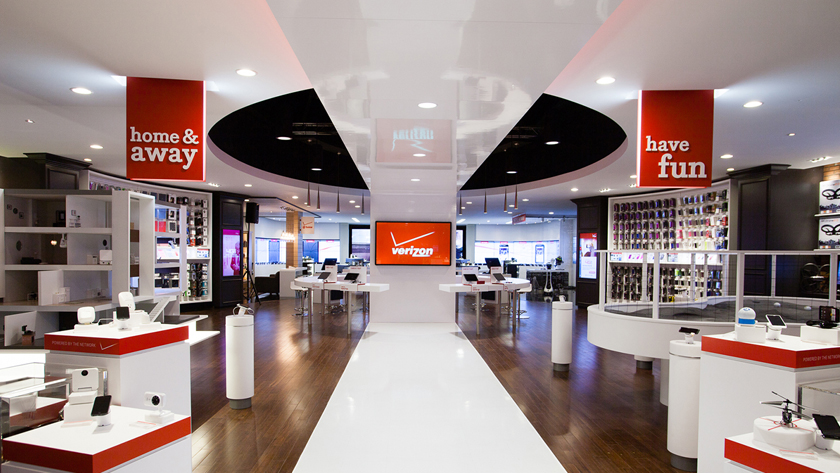Verizon is the second largest wireless mobile network operator in the United States with around 153 million subscribers. That’s nothing to sneeze at. In fact, they’re neck-and-neck with AT&T’s reported 159 million subscribers, followed by T-Mobile (83 million) and Sprint (54 million).
Despite being the second most popular carrier in the US, Verizon’s 4G LTE network is actually the largest in the country, covering more places on the map than any other network. Verizon says their 4G LTE network currently covers 98% of people living in the US (approximately 326 million people), so if wondering whether Verizon is good in your area, the answer is almost always an enthusiastic yes.
In this post, we’ll discuss the wireless technology behind Verizon’s network, frequency bands, 4G LTE, their upcoming 5G network, and why all of it matters to you as an existing or potential new customer.
What’s the difference between Verizon 3G, 4G, and 5G networks?
When it comes to Verizon’s wireless technology, they currently take advantage of 3 different network types: 5G Ultra Wideband, 4G LTE (Long Term Evolution) and 3G (CDMA). For those unaware, 3G, 4G, and 5G simply refer to the “generation” of wireless technology in question. Let’s explore each of these generations in more detail.
Verizon 3G
Similar to how 1G introduced the world’s first analog cell phones and 2G brought with it messaging and voicemail, 3G introduced wireless technology that could finally deliver a full web browsing experience, file and image sharing, streaming video and GPS tracking. As time passed and the internet became more rich with multimedia, 3G was an aging technology that simply couldn’t keep up to the demands of internet hungry devices. With Verizon’s 3G (CDMA) service officially set to retire on January 1st, 2020, Verizon is ready to close the book on 3G for good.
Verizon 4G
Of course, as network technology evolved, Verizon managed to fully transition to 4G LTE for their voice and data services. 4G LTE (Long Term Evolution) is much better at handling the demands of today’s smart devices. This is thanks to 4G LTE data speeds reaching anywhere between 5 and 12 Mbps (10 times faster than previous 3G speeds), and peak download speeds just shy of 50 Mbps. Verizon 4G LTE is faster and more reliable than 3G, delivering HD voice for crystal clear calls and the ability to stream HD media with little issue. Today, Verizon’s 4G LTE network covers 98% of the country and with that milestone, they’ve already begun work on launching 5G in a handful of cities across the US.
Verizon 5G
With Verizon’s 4G LTE already fully deployed around the country, we can now look ahead to the next generation of wireless broadband: 5G. The Verizon 5G Ultra Wideband network is faster and more powerful than their previous 4G LTE network. This is because, currently, Verizon 5G operates at a much higher frequency than current 4G LTE and is capable of delivering faster data speeds, and is able to handle more traffic during heavily congested hours or large events. Early tests have shown the 5G gigabit network already capable of delivering 1.13 Gbps data speeds, with peak speeds promised to hit 10Gbps in the near future.
When will Verizon 5G be available?
So when can we get our first taste of Verizon 5G? The good news is that Verizon’s 5G network has already begun rolling out to a few major cities across the US. According to Verizon, they plan to bring 5G to over 30 cities through 2019, so they certainly have their work cut out for them.
The only downside to Verizon’s early 5G rollout is that only a handful of phones currently support Verizon 5G, but we can expect that number to grow as Verizon’s 5G rollout continues to expand in 2020.
Verizon 5G coverage
Although Verizon’s 5G coverage map isn’t available yet, they have provided a list of cities — and outdoor/indoor sports arenas — where 5G is currently up and running in some capacity. Here are just a handful of cities where you’ll find Verizon 5G:
Of course, this is just a tip of the iceberg. For more on Verizon’s 5G coverage, head on over to our blog post “Verizon 5G rollout – overview, progress, and updates.”
How is Verizon’s network different from the others?
While most of the world (including AT&T and T-Mobile) built their networks around the GSM standard, Verizon chose to go with CDMA (Code Division Multiple Access) technology to handle their voice, text and 3G data services.
Unlike GSM networks which used SIM cards that could be swapped in and out of different devices, Verizon’s CDMA network required each individual device be activated using a unique electronic serial number (ESN).
Of course, there are more technical ways that Verizon’s network differed from others (for instance, their use of low frequency bands for greater nationwide coverage), but for consumers, this is how Verizon’s network became known as being different than the others.
Using an unlocked phone on Verizon
Want to bring your newly purchased phone to Verizon or their more affordable prepaid brand Visible? Your phone will need to be compatible with the carrier’s frequency bands in order to work properly (make calls, send messages, access the internet). This means you could either buy a Verizon specific phone, or bring your own unlocked device that supports Verizon’s network.
What is a locked phone?
There are two types of phones in the world: locked and unlocked. A locked phone is typically one purchased (usually financed) through a carrier and can’t be used on any other network. Phones purchased through Verizon are locked to their network for 60 days after purchase, a move Verizon says is to help with fraud and theft.
Once a locked phone has been fully paid off, the owner can then request the original carrier “unlock” it. This will allow the phone to be used on any other compatible network of your choosing.
What is an unlocked phone?
Occasionally you may come across an “unlocked” version of a phone. These could either be carrier specific phones that have been successfully unlocked — for instance, an AT&T unlocked iPhone 8 — or special manufacturer versions of a phone that come pre-unlocked.
When buying an unlocked phone from the manufacturer (like Apple or Google), often times these models support a wider range of frequency bands, making them perfect for use on many networks in their country of origin. American versions are usually labled as “US carrier unlocked” models, while unlocked models from other countries (which have slightly different radio frequencies) are typically labled as “international unlocked” models. When in doubt, always check the specific model number of the device to see if it’s a specific carrier unlocked, US unlocked, or international unlocked model.
Network compatibility aside, some carriers are still picky with the devices they allow to operate on their network. If you’re looking to bring your own unlocked phone to Verizon, it’s best to call Verizon and see if they’ll allow the device to be activated on their network, even if it supports all of Verizon’s frequency bands. Existing Verizon customers with an already active SIM card can usually bypass this step by simply placing the active SIM inside their new device.
Verizon network bands and frequencies
| Verizon Network Band | Frequency | Tech | Gen |
|---|---|---|---|
| LTE FDD Band 2 | 1900 MHz | LTE | 4G |
| LTE FDD Band 4 | 1700/2100 MHz (AWS) | LTE | 4G |
| LTE FDD Band 5 | 850 MHz | LTE | 4G |
| LTE FDD Band 13 | 700 MHz | LTE | 4G |
| LTE FDD Band 66 | 1700/2100 MHz (AWS) | LTE | 4G |
Verizon currently uses 5 different frequency bands for their network. For those looking to activate an unlocked phone on Verizon, ideally it should support all the carrier’s frequency bands if you’re looking for the best compatibility without any service issues.
Of these bands, only Band 13 is absolutely required to operate on Verizon’s network. Just keep in mind that without full compatibility, your phone may work in most places on Verizon, but you could find yourself with unreliable cell service, or worse, none at all.
To compare the network bands of Verizon’s with those from AT&T, T-Mobile and Sprint, head on over to our carrier networks page.
What’s the difference between bands and frequencies?
A network band is simply a number designated to a specific radio frequency (or set of frequencies) and for the most part are used interchangeably.
Frequency bands are regulated by the Federal Communications Commission (FCC) who auctions frequency blocks and allows multiple networks to share the same frequency band. These blocks are a lot like channels, so if a carrier wants in on 700MHz spectrum (band 13), AT&T and Verizon can own different “channels,” allowing both to share the same band simultaneously.
So band 2 on Verizon refers to the same band/frequencies as those on T-Mobile and so forth. This is especially great news for users shopping for unlocked phones. By looking at the specific bands a phone is compatible with, you can easily tell if the phone will work on AT&T, T-Mobile, Verizon, Sprint or all the above.
Network bands are also used around the world (thanks to a global initiative by the 3GPP), so no matter which country you go to, you’ll find radio bands in the US match the same frequencies as those used in Europe or Asia. Again, this is great news if you happen to find a great deal on an unlocked international phone that you’re looking to use in the US.
Why does it matter that Verizon has some network bands others don’t?
When looking at frequencies, the lower the frequency, the better the coverage and building penetration, but the lower bandwidth. The higher the frequency, the faster it can transmit large amounts of data, but again, this comes at the cost of range.
Since Verizon owns a good amount of 700MHz spectrum, the lower frequency is what helped them expand their coverage to the far reaches of the US, a big reason why Verizon claims to have the largest 4G LTE network in the country. For their 5G Ultra Wideband network, Verizon is using 28 GHz mmWave which is said to work well inside dense, urban envorinments, but since it’s high-band spectrum, is currently lacking in overall coverage.
*****
And that should cover most of it. Hopefully with all the information found in this post, you should have a much better idea of the technology behind Verizon’s wireless network. Whether you’re a current Verizon customer or plan to be in the near future, you’ll need a compatible phone to go along with it. Simply hit the button below to get started shopping for gently used Verizon phones. And whether you’re in need of customer service or tech support, you can also find Verizon’s contact info here.




